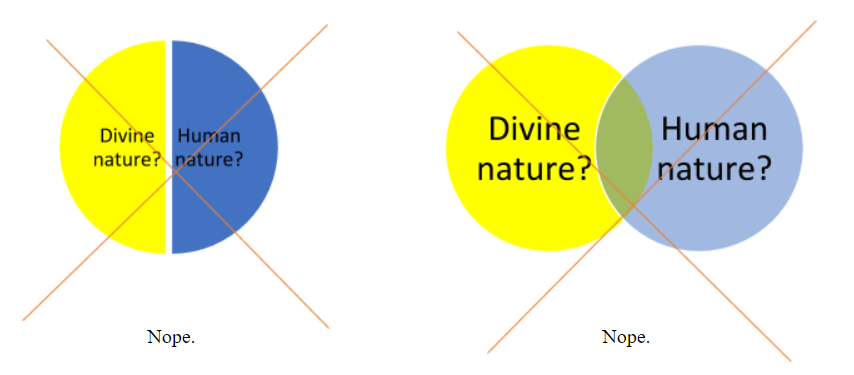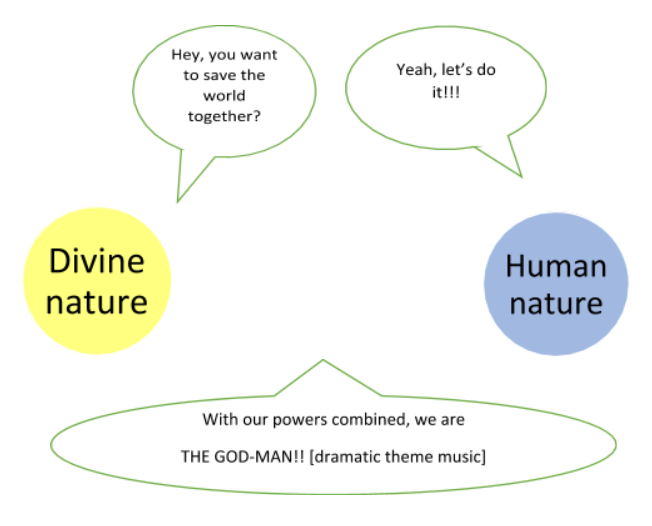If there are two central mysteries of Christianity, they are the Trinity and the incarnation. Although the councils of Nicaea and Constantinople ensured once and for all the church’s teaching on the Trinity, it left open the question of how to understand the personhood of Jesus. Put simply: If Jesus is God, then how can we “reconcile” Jesus’ divinity with his humanity?
Many modern-day Christians try to come up with their own answers. One popular explanation that has appeared in the past few decades is the idea that Jesus had to “give up” his divinity in order to become human (more on that later). What these Christians don’t realize is that the church has historically done all the hard work and heavy lifting for them. The result was the Chalcedonian Definition.
A “Definition”
The Chalcedonian Definition, also known as the Chalcedonian Creed, was finalized at the Council of Chalcedon in 451 A.D. It is the result of decades of debate and discussion on how to talk about Christ. Although its technical language might seem overwhelming at first, the gist of the Creed can be summed up like this: Jesus Christ is simultaneously fully God and fully man. He’s not 50% God and 50% man. He’s not 60/40 or 75/25. He is 100% God and 100% man at the same time. (Some Sunday school teachers put it in a cute manner by saying “He’s a 200% person!”)
Another way of phrasing this is that Jesus Christ is one person with two natures (a divine nature and a human nature). This doctrine would become known as the hypostatic union: the idea that the eternal Second Person of the Trinity — God the Son — “united” himself to humanity by taking on a human nature in addition to his divinity.
When we hear that God “became” human in Jesus Christ, we automatically try to comprehend what that looks like using pie-charts or Venn diagrams on how the natures relate to each other (see below for two ways not to visualize the person of Jesus).

But it is best to use the Chalcedonian Creed as a starting point first. The church arrived at these conclusions after decades of looking into Scripture and ruling out several heresies, which they address with phrases throughout the Creed. Here are some of the heresies they addressed:
“Without Confusion:” Contra Eutychianism
One of the heresies that the Creed addresses is one that I like to call “super-human Jesus,” “cross-hybrid Jesus,” or “mutant Jesus,” but is perhaps best known as “Eutychianism.” A preacher named Eutyches claimed that Christ’s divine and human natures combined or “mixed” to create an entirely new nature — a third “thing” (or “tertium quid” in Latin). When visualized, it might appear like the colors yellow and blue combining to create green (see below).

But if this were true, then Jesus’ human nature would simply disappear into the infinite divine nature, like a drop of ink into an ocean. He would then cease to be fully and truly human. Furthermore, as Gregory Nazianzen (a church father) once said, “What is not assumed cannot be healed.” If Jesus did not assume a fully human nature to truly become one of us, then he could not be our Savior.
Finally, the gospels portray a Jesus that is like us in every way (Hebrews 2:17) except for sin (Hebrews 4:15). As a boy, Jesus grew in wisdom and stature (Luke 2:52). He could become hungry, thirsty, and tired (Matt. 4:2; John 4:6-7; Mark 4:38). He was truly human.
To highlight this, the Creed states that his divine and human natures were “without confusion” or “without mixture.”
“Without Change:” Contra Kenoticism
The other extreme is what I like to call “werewolf Jesus.” It is to overemphasize Jesus’ human nature at the expense of his divine nature (remember, the two exist simultaneously: he is fully God and fully man). Many modern-day charismatics make this mistake when they claim that Jesus had to surrender his divinity in order to become a human.
If we were to visualize it again, it would be something like below. Notice that Jesus’ divine nature is completely gone and that he “transforms” into a human (hence “werewolf”).

This mistake is based on a misunderstanding of the Greek word “kenosis” (meaning “to empty”) found in Philippians 2:7, which states that Christ “emptied himself.” But upon further inspection, the passage says nothing about Jesus “subtracting” his divine nature. It simply talks about Jesus taking on a human nature (“in the form of a servant”). In other words, God gave himself a human nature without ceasing to be divine. I once heard someone cleverly put it this way: Jesus “emptied” himself by addition (not by subtraction). That is why he is a “200% person.” (For further reading, click here, here, and here.)
One helpful analogy is that of an English-speaker traveling to a French-speaking country. In speaking French to the citizens, he does not cease to be what he is — a naturally born English-speaker. Rather, in order to communicate to the French speakers, he lays aside the exercise of his English. In a similar way, God does not cease to be divine. Rather, he lays aside the explicit use or exercise of his divine attributes in order to relate to us on a human level, while remaining divine.
This is because God is eternal. He transcends time and space. He is not subject to change like we are. He is eternally God by nature and by necessity. This is why the Creed explicitly states that God’s nature is “without change.” God’s divine nature did not “change” or “transform” into a human nature. Furthermore, if Jesus was merely a human (and not fully God), he could not save us, because only God can save. Thus, it is imperative that we emphasize the divinity of Jesus just as much as his humanity.
“Without Division or Separation:” Contra Nestorianism
The last heresy that the Creed addresses is what I like to call “split-personality Jesus,” or “Nestorianism.” Nestorius refused to refer to Mary as the “God-bearer” (or the one who bore God in her womb), preferring instead to call her “the Christ-bearer.” The unfortunate implication, however, is to treat God and Christ as separate persons. Nestorius was essentially acting as if Christ’s divine and human nature had personalities of their own and could act independently of each other. It would look something like the goofy illustration below:

However, Jesus Christ is fully God. Therefore, Mary could rightly be called “the God-bearer” because she bore Jesus, and Jesus is God. It’s not that Mary produced God’s divine nature, but that the eternal second Person of the Trinity, God the Son, truly experienced a human birth through his human nature. In this sense, the overplayed Christmas song “Mary, Did You Know” at least gets it right when it sings, “When you kissed your little baby, you kissed the face of God.” You cannot separate his human nature from his divine nature (and vice versa). They remain together and intact, albeit distinct. As the Creed puts it, “the distinction of natures being in no way annulled by the union, but rather the characteristics of each nature being preserved and coming together to form one person…”
In Short…
So where does that leave us in understanding Christ’s human and divine natures? If you were to “visualize” it, it would look something like this:

The yellow circle represents Jesus in his divine nature, the blue circle represents Christ’s human nature (but not a separate person), and the blue circle is imposed upon the yellow circle while both simultaneously exist without mixing the colors. Finally, the yellow circle is behind the blue circle such that when you “look” at Jesus, you initially see his humanity first and foremost. But there are moments in the gospel when his divine nature is briefly unveiled, such as in the Transfiguration (Matthew 17:1–8, Mark 9:2–8, Luke 9:28–36 — hence why the yellow circle “peaks” behind the blue circle).
As we approach Advent, it will be appropriate to remember and sing along with the lyrics of “Hark! The Herald Angels Sing:” “Veiled in flesh, the Godhead see; hail the incarnate Deity!”
The incarnation is a wondrous mystery to behold: that Jesus Christ is truly the eternal God “with us” (Matt 1:23), and yet he has become “like us” in every way.
The Chalcedonian Definition
“THEREFORE, following the holy fathers, we all with one accord teach men to acknowledge one and the same Son, our Lord Jesus Christ, at once complete in Godhead and complete in manhood, truly God and truly man, consisting also of a reasonable soul and body;
of one substance with the Father as regards his Godhead, and at the same time of one substance with us as regards his manhood; like us in all respects, apart from sin; as regards his Godhead, begotten of the Father before the ages, but yet as regards his manhood begotten, for us men and for our salvation, of Mary the Virgin, the Godbearer;
one and the same Christ, Son, Lord, Only-begotten, recognized in two natures, without confusion, without change, without division, without separation;
the distinction of natures being in no way annulled by the union, but rather the characteristics of each nature being preserved and coming together to form one person and subsistence, not as parted or separated into two persons, but one and the same Son and Only-begotten God the Word, Lord Jesus Christ;
even as the prophets from earliest times spoke of him, and our Lord Jesus Christ himself taught us, and the creed of the fathers has handed down to us.”
Author’s Note I: This link is a playlist of videos that discuss the two natures of Christ, or “Christology”. The first three are short video illustrations. The next two are brief lectures by theologian Fred Sanders, which are the most helpful talks I have heard to discuss the hypostatic union.
Author’s Note II: This article is part of an ongoing series where we explore the creeds and confessions of church history. We have officially concluded our survey of the ancient Christian creeds of the early church. Next, we will transition into the Reformation era to examine the “confessions” that arose in response to Roman Catholicism. We will begin with the Thirty-Nine Articles of the Church of England.

